Iconic London Bridges
When you think of iconic London bridges, famous river crossings that define the city’s skyline and history. Also known as London river landmarks, these structures aren’t just for getting from one side to the other—they’re part of who London is. Each one tells a story: some were built to move goods, others to impress, and a few just to survive wars, floods, and time.
Take Tower Bridge, the drawbridge with towers and glass walkways that’s been lifting ships since 1894. It’s not a castle—it’s a working machine. Every day, its bascules rise for tall ships, and tourists walk above the traffic on clear glass floors. Then there’s London Bridge, the oldest crossing point on the Thames, rebuilt so many times no one’s sure which version is the "real" one. The current one? Plain, functional, and utterly unglamorous—yet it’s stood where Roman traders first stepped over the river nearly 2,000 years ago. And don’t forget Millennium Bridge, the sleek, silent walkway that wobbled on day one and became a quiet marvel of modern design. It doesn’t carry cars or trains—it carries people thinking, walking, taking photos, falling in love.
These bridges connect more than banks of the Thames. They link past and present, tourists and locals, engineers and poets. You’ll find them in the background of selfies, in old war films, in quiet morning runs. They’re the silent stage for London’s daily life. And in the posts below, you’ll see how they show up in unexpected ways—like a hotel package with a bridge view, a museum exhibit on river trade, or even a cocktail bar that named its signature drink after a bridge’s lift mechanism. There’s no single way to experience them. But if you’ve ever stood on one at sunset, watching a barge slip through the opening, you know why they still matter.
- Elara Markham
- December 6, 2025
- Comments 0
Architectural Marvels: London's Lifestyle Bridges Worth Visiting
- Colton Whitlock
- October 31, 2025
- Comments 0

